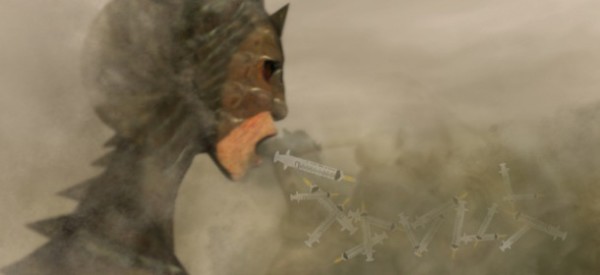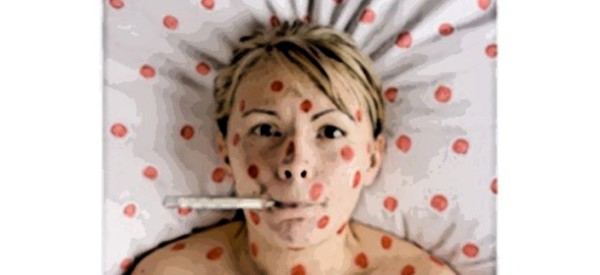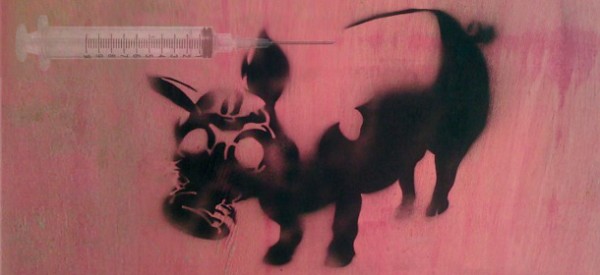Conventional Medicine
Whooping Cough Outbreaks in Vaxed Children More and More Frequent
 The lesson of these outbreaks is that the modern medical paradigm is deeply flawed. Now it’s caught with its knickers down and no decent explanation, since those it claims to have protected are victims.
The lesson of these outbreaks is that the modern medical paradigm is deeply flawed. Now it’s caught with its knickers down and no decent explanation, since those it claims to have protected are victims.
by Heidi Stevenson
(Orig. pub. June 2011)
Incidents of whooping cough have been growing more and more common since the mid-nineties, according to a report in the American Journal of Nursing(1) Those most likely to be infected are infants. However, there has been an increasing trend to the disease in adolescents and adults.
Further complicating the picture is that there are two kinds of bacteria that cause whooping cough: Bordetella pertussis and Bordetella parapertussis. Only one, B. pertussis has an associated vaccine. Is vaccination for B. pertussis causing these whooping cough outbreaks by providing a breeding ground for its cousin, B. parapertussis?
The Two Diseases
The two whooping cough diseases, which we’ll simplify to pertussis and parapertussis, are nearly indistinguishable in terms of symptoms. Pertussis is generally considered the more severe disease. The cough lasts longer and tends to be more severe. It generally starts with catarrhal symptoms, much like a cold with stuffy nose or congestion. This last from a week to ten days. Then, the cough starts. It tends to be severe with a whooping sound on the intake of breath. This can last from a few days to several weeks. Finally, a period of recuperation that may be brief or last for weeks or even months, depending upon the patient’s strength.
Parapertussis is much the same. Though it’s generally considered to be milder and briefer, pertussis is also noted to often be mild, and can even occur without obvious symptoms. These mild cases may be quite common. It’s believed that many diagnosed cases may be the result of exposure to people with silent pertussis. It is, in fact, impossible for any clinician to distinguish between the two diseases without testing. Even with testing, they are not easy to distinguish because the pertussis bacterium can be diagnosed for only a relatively short period during the disease and is difficult to isolate. Tests result in a large number of false positives and false negatives.
Obviously, there is much confusion about which disease people have. Since it’s believed that many people are not diagnosed because of relatively low severity, the reality is that prevalence is not well understood. It is also known that people may be infected with both at once, though it’s generally believed that symptoms can be produced by only one at a time.
The one thing that is apparent about whooping cough is that it’s becoming more common, and the victims are proving to be vaccinated more often than not. That, of course, doesn’t stop the vaccinators from blaming unvaccinated people for the outbreaks—though there never seems to be an adequate explanation for the claim.
Most recently, an outbreak of whooping cough hit Smithtown, New York. Thirteen students, all of whom were vaccinated, were affected. Last year, California reported 9,477 cases of whooping cough, with 10 deaths. The numbers were unrelated to vaccination rates. So far this year, there have been over a thousand cases in California.
Outbreaks have been occurring in many areas of the United States, and they seem to be unrelated to vaccination status. Officials often blithely claim that vaccinated children do not suffer as badly, but that seems to be nothing more than one of those sounds-good-so-we’ll-say-it claims with no attempts to verify whether it’s true. If true, then one would imagine that officials would be hyping relatively fewer deaths in vaccinated children—but they aren’t.
In California, last year’s death rate from whooping cough was one-tenth of one percent. The death of anyone is tragic. However, looking at the full picture is necessary to determine relative risks. We have a real-life example of a 0.1% death rate in people diagnosed with whooping cough—most assuredly nowhere near the total number who actually had it. Therefore, it is safe to assume that the death rate for whooping cough is well below one in a thousand cases.
Adverse Effects of Pertussis Vaccine
The risks of the pertussis vaccine are serious. Extremely high temperatures, high pitched keening cries indicative of encephalitis, convulsions, and brain inflammation are all devastating effects suffered by some children. Unfortunately, we do not know the prevalence of these adverse effects, as they are not consistently recorded.
We do know that babies who die from the effects of encephalitis, convulsions, and brain inflammation are rarely recorded as vaccine induced deaths—but, as many parents can attest, many of them are.
Since 1933, the pertussis vaccine has been associated with sudden infant death syndrome, also called crib or cot death. How many cases of cot death are caused by the vaccine? That’s a good question, because it’s generally treated as having an unknown cause.
The relative value of a vaccine that’s known to have limited benefit and causes severe adverse reactions is difficult to calculate without honest studies to determine the risks of the vaccine. However, with the rising rate of autism and other neurological deficits in children, along with the studies on baby monkeys by Dr. Wakefield demonstrating neurological dysfunction in vaccinated newborns, there is good reason to refuse the pertussis vaccine as too dangerous.
What Is Causing These Outbreaks?
So, what do we really know about the increasing outbreaks of whooping cough? The only statement that can be made with clarity is that vaccinations are failing.
If pertussis vaccinations ever worked, then they are losing effectiveness. If they never worked, then something is making us more susceptible to whooping cough. There are many possible reasons for this:
- The vaccinations could be causing the evolution of new strains of whooping cough.
- The vaccinations could be damaging the immune system, making us more susceptible to whooping cough.
- The pertussis vaccinations could be opening the door for the sister disease, parapertussis.
What we know about these outbreaks is minimal. We don’t even know which bacteria are associated with them. However, we do know that, if pertussis vaccinations ever did work, they are losing effectiveness. As we’ve seen in antibiotic resistant microbes, more virulent diseases are replacing those that the original antibiotics treated. Could this be happening with whooping cough?
We are still in the early stages of the changing whooping cough scene. The current medical paradigm will not support open research into the reason for these new epidemics. After all, they claim that it would be “unethical” to do placebo testing of vaccines. Obviously, they have simply been assuming that vaccines are effective. No vaccine has ever been tested in the manner that modern medicine insists is the gold standard!
The Lesson of Whooping Cough Outbreaks
We must realize that we do not live in a perfectly safe world. For each protective device, there is a trade-off. Even if vaccines do provide some protection, they do so at a cost.
That price can be very steep. The risks of sudden death in infants, deaths and disability from encephalitis, autism, and a host of other conditions, such as asthma and diabetes, which have been associated with vaccinations, are serious. Before vaccinating, consider all factors—and don’t trust the people who profit from giving vaccinations to tell you the truth.
Claims of benefits from vaccines are made based solely on diminishing rates of disease, in spite of those diseases already being in decline when they were introduced, and other nonvaccinatable diseasesa, such as scarlet fever and cholera, also declining. Then, when outbreaks occur among the vaccinated, they illogically blame the unvaccinated and use the outbreaks as an excuse to further promote vaccination!
The real lesson of these outbreaks of whooping cough is that the modern medical paradigm is deeply flawed. It presumes to know the truth without anything to back it up beyond wishful thinking. It then protects itself by claiming that investigating whether its assumptions are correct would be “unethical”.
Sources:
- Emerging Infections: Pertussis on the Rise
- Bordetella pertussis and Bordetella parapertussis: Two Immunologically Distinct Species (PDF)
- Whooping cough outbreak on Long Island
- Pertussis (Whooping Cough) (CDC report of outbreaks)
- Pertussis (Whooping Cough) & Pertussis Vaccine
- Vaccination Is Steady, but Pertussis Is Surging
- Increasing Number of Pertussis Outbreaks Prompt CDC Health Alert
- Acellular pertussis vaccination enhances B. parapertussis colonization
Tagged big pharma, Bordetella parapertussis, Bordetella pertussis vaccine, conventional medicine, cot death, crib death, Incidents of whooping cough, medical paradigm, modern medicine, pertussis, pertussis vaccine, pertussis vaccine adverse effects, sids, sudden infant death syndrome, vaccine, vaccine cot death, vaccine crib death, vaccine effectiveness, vaccine limited benefits, vaccines, whooping cough, whooping cough vaccine













